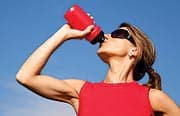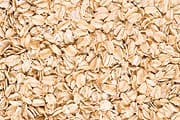Life Extension Magazine®
Without protein supplementation, more than half of all adults could eventually face the progressive, age-related loss of vital muscle tissue known as sarcopenia. Vegetarians and those following a cholesterol-restricted diet may be at a higher risk of protein deficiency that could lead to this degenerative condition that results in a 5-10% loss of muscle mass per decade after age 40. Sarcopenia increases the risk of falls, injuries, and loss of functional capacity.1 At the beginning of the 21st century, sarcopenia was responsible for 1.5% of total health care expenditures in the United States, with an annual cost of $18.5 billion.2 Mainstream doctors rarely discuss this health threat with their patients because most lack the training to successfully prevent or treat the condition. In this article you will learn about a plant-based protein supplement enriched with branched-chain amino acids and glutamine that can help avert age-related muscle loss and promote recovery from exercise. This supplement contains a proprietary blend of pea, rice, and artichoke proteins and mixes with water to make an instant low-fat, cholesterol-free drink with a biological value and digestibility score equal to whey and egg protein. Unlike most protein drink mixes on the market, this cutting-edge formula contains no common allergens like dairy or egg, and provides cholesterol-lowering beta-glucan fiber and the prebiotics agave inulin and FOS to support digestive health and immune function. Why Aging Individuals Need More ProteinResearch has firmly established the anabolic (tissue-building) effect of protein supplementation on muscle mass in aging humans, with and without exercise.3-5 Contrary to popular belief, clinical studies reveal that older adults can benefit from higher amounts of high-quality protein each day even more than active younger people.6-9 Although protein synthesis and skeletal muscle mass are regulated by a host of factors, the fundamental prerequisite for muscle protein synthesis is dietary-derived amino acids. Surprisingly, the recommended daily intake (RDI) for protein established by the Institutes of Medicine is the same for all adults—0.8 grams per kilogram of body weight. This translates into 58 grams for an aging adult weighing 160 pounds. Yet considerable evidence reveals that the protein requirement for healthy older adults is 1.0-1.3 g/kg body weight,10-12 which translates into 73-94 grams for an aging adult weighing 160 pounds. This contradiction indicates the federal government’s protein intake recommendation is up to 38% less than what published scientific studies indicate is needed. Clinical research suggests that eating a diet rich in cholesterol-free, high-quality vegetable protein can lead to favorable changes in cardiovascular risk profiles in adults of all ages. For example, a recent study found that overweight, hyperlipidemic men and women (ages 21-70) who were fed a reduced-calorie diet abundant in high-quality vegetable protein achieved similar weight loss but superior reductions in blood pressure and LDL-cholesterol compared to a matched group of adults fed a high-carbohydrate, lacto-ovo vegetarian diet (containing low-fat dairy and eggs).13 A new proprietary plant protein product enriched with branched-chain amino acids and glutamine has a perfect PDCAAS (protein digestibility corrected amino acid score) of 1.0 (100%), which is equal to the PDCAAS of whey and egg.14 The PDCAAS has been adopted by Food and Agriculture Association (FAO) and World Health Organization (WHO) as the preferred standard for measurement of protein value in human nutrition.15 Converting Ingested Proteins into Body Proteins
When proteins are ingested, they are transformed in your cells through a process known as “protein synthesis” into vital structures that make up a considerable amount of your anatomy. Aging results in a reduction in cellular protein synthesis within our body. Fortunately, just a modest bout of physical activity in older individuals may be able to restore the ability of insulin to stimulate muscle protein synthesis.16 A more recent study found that amino acid supplementation with 15 grams/day of essential amino acids for three months increased muscle synthesis and lean body mass in older women.17 Study investigators concluded, “The acute anabolic response to essential amino acids supplementation is maintained over time and can improve lean body mass, possibly offsetting the debilitating effects of sarcopenia.” Shore Up Aging Muscles with Branched-Chain Amino AcidsThe branched-chain amino acids (BCAAs)—leucine, isoleucine, and valine—are essential amino acids that play important metabolic roles, particularly during exercise and in the maintenance and growth of skeletal muscle. BCAAs account for 35% of the essential amino acids in muscle proteins and can serve as an energy source for muscle tissue during exercise. Leucine, the most metabolically active branched-chain amino acid (BCAA) promotes muscle tissue synthesis.18-20 Notably, leucine is a potent activator of a signaling pathway in human skeletal muscle that favorably modulates insulin sensitivity and the body’s anabolic drive.21,22 While it is widely acknowledged that aging muscle becomes progressively resistant to the stimulatory effects of normal postprandial concentrations of leucine,23 several animal studies show that this deficit can be overcome by feeding supplemental leucine with typical mixed nutrient meals.24-26 These findings emphasize the tremendous potential of taking supplemental leucine with meals in order to maximally stimulate muscle protein synthesis.27 Glutamine: An Essential EnergizerGlutamine is the most abundant free amino acid in the body and accounts for more than 60% of all free amino acids in plasma and muscle tissue.28 L-glutamine easily crosses the blood-brain barrier. Once in the brain, glutamine is converted into L-glutamic acid, which the brain can use for fuel should glucose, the brain’s preferred energy substrate, be in short supply.29 Glutamine is intimately involved in a number of key metabolic functions, including as an energy source for endothelial, intestinal, and lymphocytic cells,30,31 a regulator of nitric oxide synthesis by endothelial cells,32 and a transport molecule to carry toxic ammonia from peripheral tissues to the liver for conversion to urea.30 In catabolic states of injury and illness, glutamine becomes conditionally essential (requiring intake from food or supplements).30,33 Extensive study has shown that glutamine is useful in treatment of serious illnesses,34-36 injury,37 infection,38,39 and mitigating treatment-related side effects of cancer,40,41 as well as promoting wound healing in postoperative patients.30,42 Legumes for Vegetarian-Based ProteinResearch has shown that consumption of high-quality vegetable protein exerts numerous beneficial effects in aging humans. A recent study found that compared to consuming 15 grams whey or milk protein (casein), ingesting 15 grams pea protein provided greater postprandial (after-meal) satiety.43 This is important for those seeking to reduce their calorie intake of fats and carbohydrates. Another study using an in vitro gastrointestinal digestion model suggested that pea protein has potential to reduce elevated blood pressure.44
Pea protein contains more glutamine than whey or egg protein, with comparable BCAA values to whey, egg, and casein. It also contains more arginine than these ‘gold standard’ animal proteins. Arginine is essential for nitric oxide synthesis, which promotes healthy endothelial function and blood vessel dilation and relaxation.45 Although numerous studies have established the value of consuming whey protein to boost tissue levels of the antioxidant glutathione, research scientists very recently discovered that compared to glutathione, pea protein hydrolysate exhibited a significantly higher ability to inhibit fatty acid oxidation and to chelate free radical-causing metals.46 | |||||
Agave Inulin and FOS: A Powerful Prebiotic Blend
Prebiotics feed beneficial intestinal bacterial flora. The natural prebiotics inulin and fructooligosaccharides (FOS) occur in more than 36,000 species of the world’s flora.47 Thus, it is almost certain that the diets of our prehistoric forebears consisted of foods rich in prebiotics.48 Presumably, the human digestive tract evolved to depend on the health-supporting properties of prebiotics. Current studies reveal that long-chain prebiotics like inulin extracted from the fiber of the agave plant, unlike many other short-chain prebiotics, arrive at the colon intact and remain longer, allowing them to effectively support the growth of the beneficial digestive tract bacteria, Lactobacilli and Bifidobacteria.49 Food scientists have devised a strategy of using agave-derived inulin and FOS in protein supplements and functional foods to promote the growth of indigenous Bifidobacteria in the gut.50 These prebiotics interact in a selective way with our intestinal ecosystem and can favorably transform its composition, providing tremendous potential for gut health, chemoprevention, and immunity.51,52 An emerging body of research suggests that consuming inulin-based prebiotics directly diminishes the risk of chronic diseases by:
Data from human studies suggests that fermentation of prebiotic carbohydrates stimulates colonic motility and promotes proliferation of Bifidobacteria, both of which have been shown to relieve constipation.70,71 In one study, fecal weight increased in response to supplementation with either FOS or inulin.72 Oat Beta-glucans For Glycemic and Cholesterol Control
Numerous animal and human studies have established oat beta-glucans as an important dietary aid in the treatment of diabetes and cardiovascular disorders. Oat bran in particular is good source of the heart-healthy soluble fiber beta-glucan.73 Oat beta-glucans have been shown to promote a healthy postprandial glycemic response.74-78 In addition, oat beta-glucans can lower cholesterol levels in adults with elevated lipid levels. One clinical study examined the effects of feeding oat bran beta-glucans to men and women with high cholesterol. Participants were able to achieve significant reductions in plasma cholesterol levels by the study’s end.79 SummaryAging adults often require more protein than younger adults—a fact established by clinical studies, yet ignored by our leading health organizations. Nearly 50% of all adults run the risk of developing sarcopenia, a serious age-related loss of muscle mass. Age-related muscle loss is a leading cause of preventable disability and loss of functional capacity in older adults. Research has shown that consumption of high-quality vegetable protein exerts numerous beneficial effects in aging humans. Adults, vegetarians, and all active people can benefit from a new proprietary protein supplement product enriched with pea and other plant proteins, branch chained amino acids, prebiotics, and cholesterol-lowering oat beta-glucans. These components work in concert to maximize protein utilization, while controlling the postprandial glycemic response that inflicts so much damage to cells after every high-calorie meal we eat. If you have any questions on the scientific content of this article, please call a Life Extension® Health Advisor at Editor's NoteScience continues to evolve, and new research is published daily. As such, we have a more recent article on this topic: Preserve Muscle and Improve Body Composition, Whey's Longevity Benefits | ||
| References | ||
| 1. Paddon-Jones D, Short KR, Campbell WW, Volpi E, Wolfe RR. Role of dietary protein in the sarcopenia of aging. Am J Clin Nutr. 2008 May;87(5):1562S-6S. 2. Janssen I, Shepard DS, Katzmarzyk PT, Roubenoff R. The healthcare costs of sarcopenia in the United States. J Am Geriatr Soc. 2004 Jan;52(1):80–5. 3. Paddon-Jones D, Sheffield-Moore M, Katsanos CS, Zhang XJ, Wolfe RR. Differential stimulation of muscle protein synthesis in elderly humans following isocaloric ingestion of amino acids or whey protein. Exp Gerontol. 2006 Feb;41(2):215–9. 4. Paddon-Jones D, Sheffield-Moore M, Zhang XJ, et al. Amino acid ingestion improves muscle protein synthesis in the young and elderly. Am J Physiol Endocrinol Metab. 2004 Mar;286(3):E321–8. 5. Campbell WW. Synergistic use of higher-protein diets or nutritional supplements with resistance training to counter sarcopenia. Nutr Rev. 2007 Sept;65(9):416–22. 6. Campbell WW, Crim MC, Dallal GE, Young VR, Evans WJ. Increased protein requirements in elderly people: new data and retrospective reassessments. Am J Clin Nutr. 1994 Oct;60(4):501-9. 7. Karakelides H, Sreekumaran NK. Sarcopenia of aging and its metabolic impact. Curr Top Dev Biol. 2005;68:123-48. 8. Young VR. Amino acids and proteins in relation to the nutrition of elderly people. Age Ageing. 1990 Jul;19(4):S10-24. 9. Houston DK, Nicklas BJ, Ding J, et al. Dietary protein intake is associated with lean mass change in older, community-dwelling adults: the Health, Aging, and Body Composition (Health ABC) Study. Am J Clin Nutr. 2008 Jan;87(1):150–5. 10. Gaffney-Stomberg E, Insogna KL, Rodriguez NR, Kerstetter JE. Increasing dietary protein requirements in elderly people for optimal muscle and bone health. J Am Geriatr Soc. 2009 Jun;57(6):1073-9. 11. Morais JA, Chevalier S, Gougeon R. Protein turnover and requirements in the healthy and frail elderly. J Nutr Health Aging. 2006 Jul-Aug;10(4):272-83. 12. Morse MH, Haub MD, Evans WJ, Campbell WW. Protein requirement of elderly women: nitrogen balance responses to three levels of protein intake. J Gerontol A Biol Sci Med Sci. 2001 Nov;56(11):M724–30. 13. Jenkins DJ, Wong JM, Kendall CW, et al. The effect of a plant-based low-carbohydrate (“Eco-Atkins”) diet on body weight and blood lipid concentrations in hyperlipidemic subjects. Arch Intern Med. 2009 Jun 8;169(11):1046-54. 14. Available at: http://www.usdec.org/Products/content.cfm?ItemNumber=82510&navItemNumber=83186.Accessed September 1, 2010. 15. Schaafsma G. The protein digestibility-corrected amino acid score. J Nutr. 2000 Jul;130(7):1865S-7S. 16. Fujita S, Rasmussen BB, Cadenas JG, et al. Aerobic exercise overcomes the age-related insulin resistance of muscle protein metabolism by improving endothelial function and Akt/mammalian target of rapamycin signaling. Diabetes. 2007 Jun;56(6):1615-22. 17. Dillon EL, Sheffield-Moore M, Paddon-Jones D, et al. Amino acid supplementation increases lean body mass, basal muscle protein synthesis, and insulin-like growth factor-I expression in older women. J Clin Endocrinol Metab. 2009 May;94(5):1630-7. 18. Koopman R, Verdijk L, Manders RJ, et al. Co-ingestion of protein and leucine stimulates muscle protein synthesis rates to the same extent in young and elderly lean men. Am J Clin Nutr. 2006 Sep;84(3):623–32. 19. Dardevet D, Sornet C, Balage M, Grizard J. Stimulation of in vitro rat muscle protein synthesis by leucine decreases with age. J Nutr. 2000 Nov;130(11):2630–5. 20. Katsanos CS, Kobayashi H, Sheffield-Moore M, Aarsland A, Wolfe RR. A high proportion of leucine is required for optimal stimulation of the rate of muscle protein synthesis by essential amino acids in the elderly. Am J Physiol Endocrinol Metab. 2006 Aug;291(2):E381–7. 21. Fujita S, Dreyer HC, Drummond MJ, et al. Nutrient signalling in the regulation of human muscle protein synthesis. J Physiol. 2007 Jul 15;582(Pt 2):813-23. 22. Dreyer HC, Drummond MJ, Pennings B, et al. Leucine-enriched essential amino acid and carbohydrate ingestion following resistance exercise enhances mTOR signaling and protein synthesis in human muscle. Am J Physiol Endocrinol Metab. 2008 Feb;294(2):E392–400. 23. Dardevet D, Sornet C, Balage M, Grizard J. Stimulation of in vitro rat muscle protein synthesis by leucine decreases with age. J Nutr. 2000 Nov;130(11):2630–5. 24. Rieu I, Sornet C, Bayle G, et al. Leucine-supplemented meal feeding for ten days beneficially affects postprandial muscle protein synthesis in old rats. J Nutr. 2003 Apr;133(4):1198–1205. 25. Rieu I, Balage M, Sornet C, et al. Leucine supplementation improves muscle protein synthesis in elderly men independently of hyperaminoacidaemia. J Physiol. 2006 Aug 15;575(Pt 1):305–15. 26. Pansarasa O, Flati V, Corsetti G, Brocca L, Pasini E, D’Antona G. Oral amino acid supplementation counteracts age-induced sarcopenia in elderly rats. Am J Cardiol. 2008;101:35E–41E. 27. Fujita S, Volpi E. Amino acids and muscle loss with aging. J Nutr. 2006 Jan;136(1 Suppl):277S–80S. 28. Walsh NP, Blannin AK, Robson PJ, Gleeson M. Glutamine, exercise and immune function. Links and possible mechanisms. Sports Med. 1998 Sep;26(3):177-91. 29. Lee WJ, Hawkins RA, Vina JR, Peterson DR. Glutamine transport by the blood-brain barrier: a possible mechanism for nitrogen removal. Am J Physiol. 1998 Apr;274(4 Pt 1):C1101-7. 30. L-glutamine. Altern Med Rev. 2001 Aug;6(4):406-10. 31. Newsholme P, Curi R, Pithon Curi TC, Murphy CJ, Garcia C, Pires de Melo M. Glutamine metabolism by lymphocytes, macrophages, and neutrophils: its importance in health and disease. J Nutr Biochem. 1999 Jun;10(6):316-24. 32. Schachter D. L-glutamine in vitro regulates rat aortic glutamate content and modulates nitric oxide formation and contractility responses. Am J Physiol Cell Physiol. 2007 Jul;293(1):C142-51. 33. Buchman AL. Glutamine: commercially essential or conditionally essential? A critical appraisal of the human data. Am J Clin Nutr. 2001 Jul;74(1):25-32. 34. Avenell A. Hot topics in parenteral nutrition Current evidence and ongoing trials on the use of glutamine in critically-ill patients and patients undergoing surgery. Proc Nutr Soc. 2009 Aug;68(3):261-8. 35. Akobeng AK, Miller V, Stanton J, Elbadri AM, Thomas AG. Double-blind randomized controlled trial of glutamine-enriched polymeric diet in the treatment of active Crohn’s disease. J Pediatr Gastroenterol Nutr. 2000 Jan;30(1):78-84. 36. Decker GM. Glutamine: indicated in cancer care? Clin J Oncol Nurs. 2002 Mar-Apr;6(2):112-5. 37. Wilmore DW. The effect of glutamine supplementation in patients following elective surgery and accidental injury. J Nutr. 2001 Sep;131(9 Suppl):2543S-9S; discussion 2550S-1S. 38. Field CJ, Johnson IR, Schley PD. Nutrients and their role in host resistance to infection. J Leukoc Biol. 2002 Jan;71(1):16-32. 39. Abcouwer SF. The effects of glutamine on immune cells. Nutrition. 2000 Jan;16(1):67-9. 40. Ziegler TR. Glutamine supplementation in cancer patients receiving bone marrow transplantation and high dose chemotherapy. Review. J Nutr. 2001 Sep;131(9 Suppl):2578S-84S; discussion 2590S. 41. Daniele B, Perrone F, Gallo C, et al. Oral glutamine in the prevention of fluorourcil induced intestinal toxicity: a double blind, placebo controlled, randomized trial. Gut. 2001 Jan;48(1):28-33. 42. Fan YP, Yu JC, Kang WM, Zhang Q. Effects of glutamine supplementation on patients undergoing abdominal surgery. Chin Med Sci J. 2009 Mar;24(1):55-9. 43. Diepvens K, Haberer D, Westerterp-Plantenga M. Different proteins and biopeptides differently affect satiety and anorexigenic/orexigenic hormones in healthy humans. Int J Obes (Lond). 2008 Mar;32(3):510-8. 44. Vermeirssen V, Van Camp J, Devos L, Verstraete W. Release of angiotensin I converting enzyme (ACE) inhibitory activity during in vitro gastrointestinal digestion: from batch experiment to semicontinuous model. J Agric Food Chem. 2003 Sep 10;51(19):5680-7. 45. Zhou MS, Kosaka H, Tian RX, et al. L-Arginine improves endothelial function in renal artery of hypertensive Dahl rats. J Hypertens. 2001;19:421-429. 46. Pownall TL, Udenigwe CC, Aluko RE. Amino acid composition and antioxidant properties of pea seed ( Pisum sativum L.) enzymatic protein hydrolysate fractions. J Agric Food Chem. 2010 Apr 28;58(8):4712-8. 47. Hendry G. The ecological significance of fructan in a contemporary flora. New Phytologist. 1987 May;106:201-16. 48. Hatley T, Kappelman J. Bears, pigs, and Plio-Pleistocene Hominids: A case for the exploitation of belowground food resources. Human Ecol. 1980;8(4): 371-87. 49. Gomez E, Tuohy KM, Gibson GR, Klinder A, Costabile A. In vitro evaluation of the fermentation properties and potential prebiotic activity of Agave fructans. J Appl Microbiol. 2010 Jun 1;108(6):2114-21. 50. Roberfroid M. Functional food concept and its application to prebiotics. Dig Liver Dis. 2002 Sep;34 Suppl 2:S105–10. 51. Gibson GR, Probert HM, Loo JV, Rastall RA, Roberfroid MB. Dietary modulation of the human colonic microbiota: updating the concept of prebiotics. Nutr Res Rev. 2004 Dec;17(2):259-75. 52. Picard C, Fioramonti J, Francois A, Robinson T, Neant F, Matuchansky C. Review article: bifidobacteria as probiotic agents-–physiological effects and clinical benefits. Aliment Pharmacol Ther. 2005 Sep 15;22(6):495-512. 53. Hoentjen F, Welling GW, Harmsen HJ, et al. Reduction of colitis by prebiotics in HLA-B27 transgenic rats is associated with microflora changes and immunomodulation. Inflamm Bowel Dis. 2005 Nov;11(11):977–85. 54. Furrie E, Macfarlane S, Kennedy A, et al. Synbiotic therapy (Bifidobacterium longum/ Synergy 1) initiates resolution of inflammation in patients with active ulcerative colitis: a randomised controlled pilot trial. Gut. 2005 Feb;54(2): 242–9. 55. Guarner F. Inulin and oligofructose: impact on intestinal diseases and disorders. Br J Nutr. 2005 Apr;93 Suppl 1:S61–5. 56. Femia AP, Luceri C, Dolara P, et al. Antitumorigenic activity of the prebiotic inulin enriched with oligofructose in combination with the probiotics Lactobacillus rhamnosus and Bifidobacterium lactis on azoxymethane-induced colon carcinogenesis in rats. Carcinogenesis. 2002 Nov;23(11):1953–60. 57. Verghese M, Rao DR, Chawan CB, Shackelford L. Dietary inulin suppresses azoxymethane-induced preneoplastic aberrant crypt foci in mature Fisher 344 rats. J Nutr. 2002 Sept;132(9):2804–8. 58. Pierre F, Perrin P, Champ M, Bornet F, Meflah K, Menanteau J. Short-chain fructo-oligosaccharides reduce the occurrence of colon tumors and develop gut-associated lymphoid tissue in Min mice. Cancer Res. 1997 Jan 15;57(2):225–8. 59. Jacobsen H, Poulsen M, Dragsted LO, Ravn-Haren G, Meyer O, Lindecrona RH. Carbohydrate digestibility predicts colon carcinogenesis in azoxymethane-treated rats. Nutr Cancer. 2006;55(2):163–70. 60. Pool-Zobel BL. Inulin-type fructans and reduction in colon cancer risk: review of experimental and human data. Br J Nutr. 2005 Apr;93 Suppl 1:S73–90. 61. Jackson KG, Taylor GR, Clohessy AM, Williams CM. The effect of the daily intake of inulin on fasting lipid, insulin and glucose concentrations in middle-aged men and women. Br J Nutr. 1999 Jul;82(1):23–30. 62. Beylot M. Effects of inulin-type fructans on lipid metabolism in man and in animal models. Br J Nutr. 2005 Apr;93 Suppl 1:S163–8. 63. Rault-Nania MH, Gueux E, Demougeot C, Demigne C, Rock E, Mazur A. Inulin attenuates atherosclerosis in apolipoprotein E-deficient mice. Br J Nutr. 2006 Nov;96(5):840–4. 64. Delzenne NM, Kok N. Effects of fructans-type prebiotics on lipid metabolism. Am J Clin Nutr. 2001 Feb;73(2 Suppl):456S–458S. 65. Jackson KG, Taylor GRL, Clohessy AM, Williams CM. The effect of the daily intake of inulin on fasting lipid, insulin and glucose concentrations in middle-aged men and women. Br J Nutr. 1999 Jul; 82(1):23–30. 66. Nzeusseu A, Dienst D, Haufroid V, Depresseux G, Devogelaer JP, Manicourt DH. Inulin and fructo-oligosaccharides differ in their ability to enhance the density of cancellous and cortical bone in the axial and peripheral skeleton of growing rats. Bone. 2006 Mar;38(3):394–9. 67. Raschka L, Daniel H. Diet composition and age determine the effects of inulin-type fructans on intestinal calcium absorption in rat. Eur J Nutr. 2005 Sep;44(6):360-4. 68. Ohta A, Ohtsuki M, Takizawa T, Inaba H, Adachi T, Kimura S. Effects of fructooligosaccharides on the absorption of magnesium and calcium by cecectomized rats. Int J Vitam Nutr Res. 1994;64(4):316–23. 69. Abrams SA, Griffin IJ, Hawthorne KM, et al. A combination of prebiotic short- and long-chain inulin-type fructans enhances calcium absorption and bone mineralization in young adolescents. Am J Clin Nutr. 2005 Aug;82(8):471–6. 70. Roberfroid M. Dietary fibre, inulin and oligofructose: a review comparing their physiological effects. Crit Rev Food Sci Technol. 1993;33(2):103-48. 71. Kelly G. Inulin-type prebiotics: a review. (Part 2.) Altern Med Rev. 2009 Mar;14(1):36-55. 72. Gibson GR, Beatty ER, Wang X, Cummings JH. Selective stimulation of bifidobacteria in the human colon by oligofructose and inulin. Gastroenterology. 1995 Apr;108(4):975-82. 73. Sadiq Butt M, Tahir-Nadeem M, Khan MK, Shabir R, Butt MS. Oat: unique among the cereals. Eur J Nutr. 2008 Mar;47(2):68-79. 74. Rondanelli M, Opizzi A, Monteferrario F. The biological activity of beta-glucans. Minerva Med. 2009 Jun;100(3):237-45. 75. Vachon C, Jones JD, Wood PJ, Savoie L. Concentration effect of soluble dietary fibers on postprandial glucose and insulin in the rat. Can J Physiol Pharmacol. 1988 Jun;66(6):801-6. 76. Braaten JT, Wood PJ, Scott FW, Riedel KD, Poste LM, Collins MW. Oat gum lowers glucose and insulin after an oral glucose load. Am J Clin Nutr. 1991 Jun;53(6):1425-30. 77. Poppitt SD, van Drunen JD, McGill AT, Mulvey TB, Leahy FE. Supplementation of a high-carbohydrate breakfast with barley beta-glucan improves postprandial glycaemic response for meals but not beverages. Asia Pac J Clin Nutr. 2007;16(1):16-24. 78. Biorklund M, van Rees A, Mensink RP, Onning G. Changes in serum lipids and postprandial glucose and insulin concentrations after consumption of beverages with beta-glucans from oats or barley: a randomised dose-controlled trial. Eur J Clin Nutr. 2005 Nov;59(11):1272-81. 79. Queenan KM, Stewart ML, Smith KN, Thomas W, Fulcher RG, Slavin JL. Concentrated oat beta-glucan, a fermentable fiber, lowers serum cholesterol in hypercholesterolemic adults in a randomized controlled trial. Nutr J. 2007 Mar 26;6:6. |





